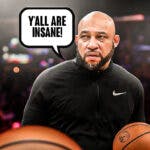Touted by many as the greatest of all time, LeBron James sits atop the NBA world. As a force of nature, he can shoot, pass, drive, rebound, and defend–all at a high level. His comparisons to Michael Jordan, who the other half of NBA fandom deems the greatest, will never end.
And yet, there is one stark difference between the two: Jordan has won six championships, and LeBron has won only three. LeBron, in fact, has lost in the NBA Finals six times, while Jordan has won in each of his six trips.
While the difference in ring count can be attributed to a variety of things, there remains one constant in LeBron's Finals losses. There is one characteristic that defines his opponents each and every time: excellent ball movement.

LeBron is one of the best one-on-one players the league has ever seen. When he puts his head down and wants to get to the basket, there may be nobody on planet Earth that is physically capable of stopping him. As a result, LeBron's teams are typically defined by great individual play.
His years as a Cleveland Cavalier early on were defined by LeBron's domination, as he played alongside role players and 3-point shooters. His years in Miami had decent ball movement, but because of the nature of having LeBron, Dwyane Wade, and Chris Bosh all on the same team, they would inevitably fall into the hole of isolation plays in the clutch. And in his second stint with the Cavs, LeBron joined another one of the best isolation players in the league, Kyrie Irving.
But while LeBron's teams are usually isolation-heavy, his opponents in the Finals are the polar opposite. Each opponent that defeated LeBron in the NBA Finals excelled in ball movement, employing a scheme that has defenses scrambling, and LeBron looking for answers. A look at each of his Finals opponent will reveal that ball movement against LeBron may be the best way to to conquer the King.

2007 and 2014: San Antonio Spurs
In LeBron James' first trip to the Finals in 2007, he was carrying the Cavaliers solely on his back. As a young 22-year-old, he shocked the NBA world with 48 points vs. the Pistons in Game 5 of the Eastern Conference Finals. That 48 included, maybe even more impressively, 25 straight points for the Cavs that spanned the 4th quarter and overtime. He was a ball-dominant player that could get his way against any team, even a Pistons squad that had just won the championship three years prior.
As he emerged out of the East, LeBron's miracle run was looking for validation. Only the San Antonio Spurs stood in the way between James and his first NBA title. But he discovered quickly that his ball domination style wouldn't work against a team like the Spurs. Known for the past two decades for their ball movement, the Spurs passed with pinpoint precision, dispatching the Cavs in just four games.
LeBron again met the Spurs in 2014. Led once again by Tim Duncan, Tony Parker, and Manu Ginobili, the Spurs ran into LeBron's Miami Heat superteam looking to cement their legacy. The Heat, with All-Stars Dwyane Wade and Chris Bosh alongside LeBron, had won the past two championships, and were aiming for a rare three-peat.
But after splitting the first two games, LeBron's star-studded lineup hit a roadblock in one of the best three-game stretches the NBA has ever seen. The Spurs activated another level of offense–one that coach Gregg Popovich believed would help slow LeBron down. It meant constant passing, constant player movement, and constant ball movement.

The system was deemed “point five” by the Spurs, since the goal was for a player to hold the ball for no longer than half a second. As a result, the ball whipped around the court faster than the Heat could catch up with. In the first half of Game 3, in what was described by ESPN as “a symphony of cutting and dribbling and passing and scoring,” the Spurs scored 71 points on a mind-blowing 75.8% shooting from the field. Those types of numbers in a half were unprecedented, especially against the best player in the game coming off of two championships.
It was sparked by their ball movement. The Heat defense had to rotate constantly, and even Manu Ginobili noticed the impact of their impeccable ball movement afterwards.
“You could sense their frustration. LeBron had to work so much, and then we'd come down and hit another 3. I'm sure that was difficult for them, for him, but Pop told us after 2013 this was the way we had to play to beat them. If we went isolation, we had no shot.”
The Spurs gave their best shot. They moved the ball so well, and beat the Heat superteam so badly, that other teams around the league started adopting move ball movement principles. Steve Kerr, a pupil of Popovich's, employed a similar system for the Golden State Warriors, who would win three of the next four championships. Mike Budenholzer, another disciple of Popovich's, used ball movement to shockingly propel his Atlanta Hawks to a 60-win season in 2015-16. Of all the teams that used a ball movement offense against LeBron, none used it as well or as efficiently as the San Antonio Spurs.

2011: Dallas Mavericks
In 2011, LeBron had just formed a superteam comprised of three All-Stars in their primes. Wade, Bosh, and James were poised to dominate the NBA for years to come. Their first NBA Finals earned them a meeting with Dirk Nowitzki and the Dallas Mavericks.
Outside of Dirk, the Mavericks boasted veterans such as Jason Kidd, Jason Terry, Shawn Marion, and Peja Stojakovic. But despite only winning one less game in the regular season than LeBron's Heat, the Mavs were massive underdogs. And after a decisive Game 1 win and a 15-point lead in the 4th quarter of Game 2, the Heat looked poised to win this series easily.
But the Mavericks' Game 2 comeback, sparked by Jason Terry and Dirk Nowitzki, became a turning point in the series. No longer were they intimidated by the mighty superteam. The Mavs used their depth and ball movement to turn the series on its head. In the Finals, only two Heat players outside of LeBron averaged move than two assists per game. The Mavs had five players averaging more than two assists a game. The difference demonstrates the willingness to share the ball by the Mavs, while the lack of numerous playmakers on the Heat, even with all their talent, ultimately spelled their demise.

2015, 2017, 2018: Golden State Warriors
Right after the 2014 Spurs' victory over LeBron's Heat, the rest of the NBA tried to emulate their ball movement. Steve Kerr, who played under Popovich, implemented his own version of a ball and player movement offense for the Warriors. The change propelled them to 67 wins and a number-one seed in the West.
The up-start Warriors faced LeBron's Cavaliers in the Finals. LeBron, who was back in Cleveland looking to deliver his hometown team a title, joined forces with All-Stars Kyrie Irving and Kevin Love. Together, they made another deadly trio for LeBron to pursue championships. However, Kyrie Irving was also a ball-dominant player who thrived in isolations, and the Cavs became a team that relied almost solely on LeBron's and Kyrie's iso playmaking.
Like the Spurs, the Warriors moved the ball exceptionally well. That season, the Warriors led the league in assists per game, according to NBA.com. The ability to keep moving the ball until they found the open man also led to the Warriors having the highest field goal percentage in the NBA that season.
An injury to Kyrie Irving in the 2015 Finals forced LeBron to be the sole playmaker for a majority of the Finals. And his one-on-one style, mixed with having to chase after Golden State's shooters all series, wore him down. LeBron's Cavs lost in six games.

In both 2017 and 2018, with the Warriors incorporating MVP Kevin Durant into their system, Golden State was even more of a juggernaut on offense. They put on a clinic in passing the ball. And even though they would sometimes fall into the same trap LeBron falls into–relying on isolation in the clutch–the Warriors stuck to their ball and player movement principles enough to defeat the Cavs in five games in 2017, and swept them in 2018. Not surprisingly, the Warriors led the league in assists per game both seasons.
LeBron James has three championships under his belt, and is in the conversation for the greatest basketball player to walk the Earth. But his six Finals losses are a glaring blip in James' otherwise otherworldly journey. And all six times have been to teams that can move the ball exceptionally well, and have sharply contrasted LeBron's isolation-heavy teams. While he's missed a portion of the games, even LeBron's new-look Los Angeles Lakers this season rank 21st in the league in assist percentage.
LeBron James' throne may be a lonely one, but he and his teammates will need to start sharing the ball more if the King wants to win more titles. The league is moving on from the ball-dominant stars of the past. Likewise, LeBron will need to move on, and move the ball, to keep up.




